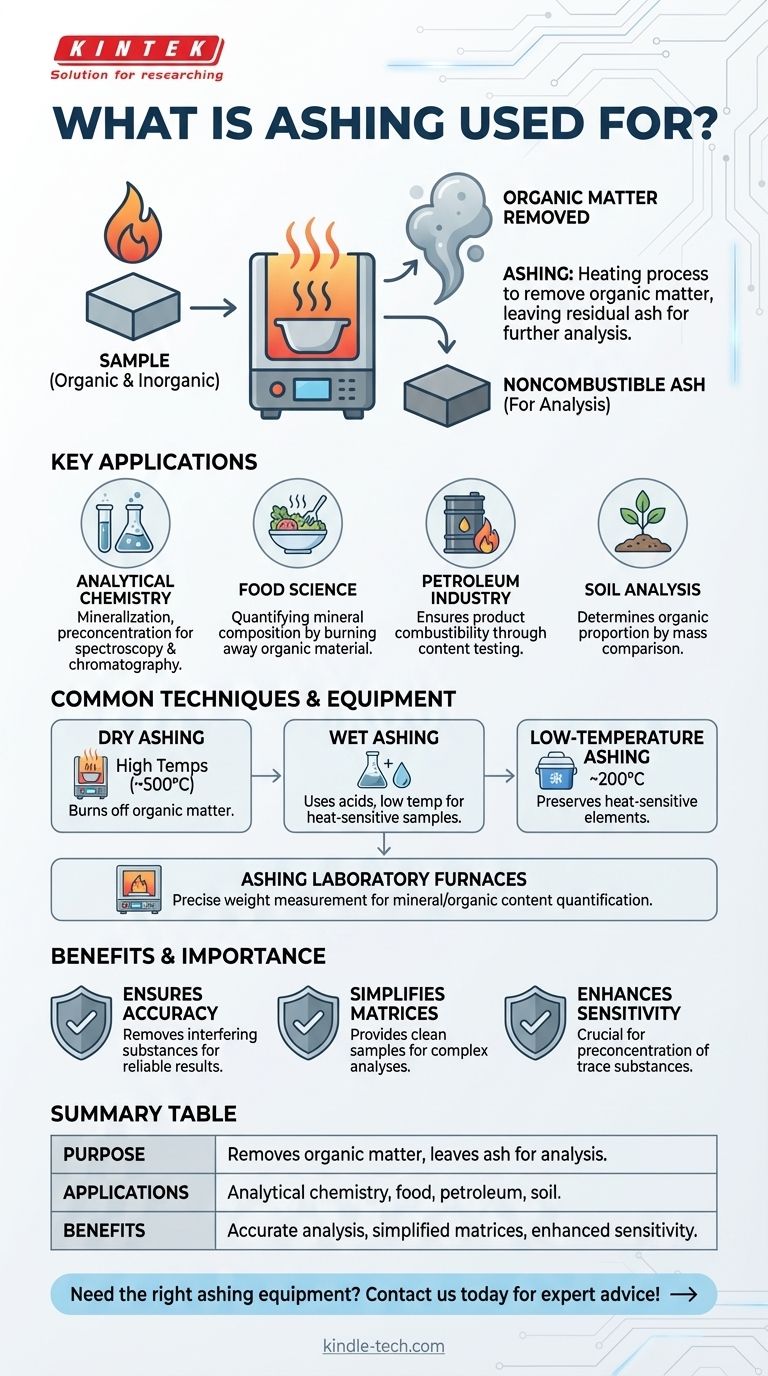灰化は、サンプルから有機物やその他の干渉成分を除去し、分析のために不燃性の灰を残すために、さまざまな産業や科学分野で使用される重要なプロセスです。これは、分析化学、食品科学、石油試験、土壌分析で一般的に採用されています。乾式灰化、湿式灰化、低温灰化などの技術は、サンプルの種類や分析要件に応じて使用されます。灰化は、鉱物組成の定量化、製品の可燃性の確保、および分光法やクロマトグラフィーなどの技術のためのサンプルの準備に役立ちます。また、微量物質の前濃縮や、土壌などの材料中の有機物含有量の決定にも不可欠です。
重要なポイントの解説:
-
灰化の定義と目的
- 灰化は、サンプルを加熱して有機物やその他の干渉マトリックス成分を除去し、不燃性の灰を残すプロセスです。
- これは、測定を妨げる可能性のある成分を取り除くことにより、正確な分析のためにサンプルを準備するため主に利用されます。
-
灰化の応用
- 分析化学:灰化は、クロマトグラフィーや分光法などの化学的または光学的分析の前に、微量物質の鉱化と前濃縮に使用されます。
- 食品科学:有機物を燃焼させることにより、食品サンプルのミネラル組成を定量化するのに役立ちます。
- 石油産業:灰化は、石油製品の含有量を試験することにより、その可燃性を保証します。
- 土壌分析:灰化の前後で質量を比較することにより、土壌の有機物含有量を決定します。
-
一般的な灰化技術
- 乾式灰化:有機物を燃焼させるために、サンプルを高温(約500°C)で加熱することを含みます。
- 湿式灰化:高温の代わりに酸を使用して有機成分を除去し、熱に弱いサンプルに適しています。
- 低温灰化:熱に弱い元素を保持するために、より低い温度(約200°C)で実施されます。
- 硫酸灰化:サンプルから二酸化硫黄を中和・除去します。
- 密閉系灰化:プロセス中に雰囲気を制御するために密閉チャンバーを使用し、精度を保証します。
-
黒鉛炉原子吸光(AA)における役割
- 灰化は、黒鉛炉AAプログラムにおける重要なステップであり、分析対象物の測定を妨げる可能性のあるマトリックス成分を除去します。
- このステップは、元素分析において正確で信頼性の高い結果を保証します。
-
サンプル調製における重要性
- 灰化はサンプルマトリックスを単純化し、残留灰の元素組成を分析しやすくします。
- これは、微量物質の前濃縮に特に有用であり、分析技術の感度を高めます。
-
灰化に使用される機器
- 灰化用ラボ炉:有機成分が燃焼除去されるにつれてサンプルの重量変化を測定するように設計されています。
- これらの炉は、鉱物または有機含有量の正確な定量化を必要とする産業にとって不可欠です。
-
灰化の利点
- 干渉物質を除去することにより、正確な分析を保証します。
- 分光法やクロマトグラフィーなどの技術のためにクリーンなサンプルマトリックスを提供します。
- さまざまな材料の鉱物含有量と有機物含有量の定量化を支援します。
これらの重要なポイントを理解することにより、機器および消耗品の購入者は、サンプル調製と分析における灰化の重要性をよりよく認識し、特定のニーズに合った適切なツールと技術を選択できるようになります。

要約表:
| 側面 | 詳細 |
|---|---|
| 目的 | 有機物を除去し、分析のために不燃性の灰を残す。 |
| 応用 | 分析化学、食品科学、石油試験、土壌分析。 |
| 技術 | 乾式灰化、湿式灰化、低温灰化、硫酸灰化。 |
| 機器 | 正確な重量測定のための灰化用ラボ炉。 |
| 利点 | 正確な分析の保証、サンプルマトリックスの単純化、感度の向上。 |
ラボに必要な適切な灰化機器をお探しですか?専門的なアドバイスとソリューションについては、今すぐお問い合わせください!
ビジュアルガイド




















